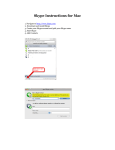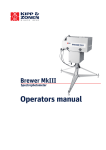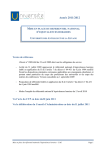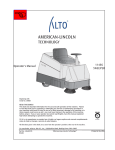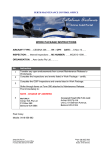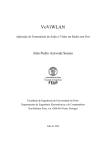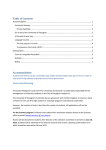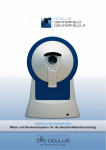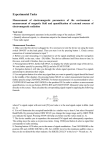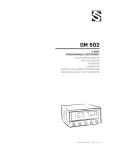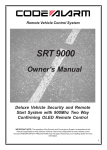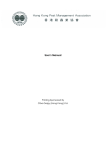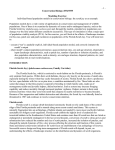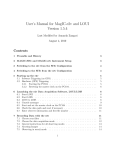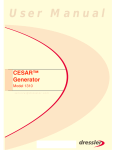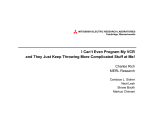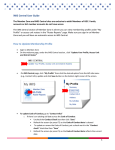Download 1. Instrument Description 2. Configuration
Transcript
1. Instrument Description The Inamori-Magellan Areal Camera and Spectrograph, IMACS, is a wide-field imaging spectrograph built at Carnegie Observatories. IMACS consists of two cameras with two different scales and spectral resolutions covering the range 500 < R < 20,000. Its detector is a single 8K x 8K CCD mosaic camera, which is shuttled between these two foci. In addition to wide-field imaging and a range of low- to medium-resolution spectroscopic modes, IMACS has a 2 x 1000 fiber-fed integral field unit (IFU) built by Durham University, IMACS has its own guiders and wavefront sensors. Associated with the instrument are two electronics racks mounted on the Nasmyth platform, and two Cryotiger compressors mounted below the Azimuth disk. The instrument uses Observatory-provided compressed air and coolant. The instrument control computer is a Linux PC currently located in the control room; the CCD mosaic camera is controlled by a Linux PC located in the equipment room. A second CCD mosaic camera is under construction and scheduled to be completed in 2007. A mutli-object echelle mode, MOE, is currently in the final stages of testing, and a full-field tunable filter, MMTF, has had a successful first engineering run. GISMO, an image-slicing reformator for dense mutlislit coverage over a 4 x 4 arcminute field, is under construction. This Support Agreement covers the following basic configurations of IMACS: o The f/2 and f/4 cameras and associated dispersers (excluding MOE) and filters o The original 8K x 8K CCD mosaic camera o The IFU unit Specifically excluded are: o MOE o MMTF o GISMO o The second 8K x 8K CCD mosaic camera 2. Configuration Specify the intended port IMACS is installed at Baade west Nasmyth. Specify the secondary mirror and ADC F/11 plus ADC/corrector Provisions for guiding: Does the instrument require one of the observatory guiders and, if so, specify which model IMACS has its own guiders: Principal Guider and Shack-Hartmann are off-axis guiders for observing; Requires 3 Magellan CCD TV cameras. Centerfield guider is for setup and on-axis Shack-Hartmann calibration Specify instrument size and weight IMACS is (generally) a cylinder 2.5-m in diameter and 5-m long. Carriage weight (stationary) is 1700 lbs; moving instrument weight ~6000 lbs. List size and location of instrument racks, compressors, and other equipment o Double 19-inch electronics rack mounted on west platform, 2-m west of instrument (telescope parked) o Two Cryotiger compressors for IMACS mosaic camera cooling, mounted below Azimuth disk o IMACS uses compressed air and water+10% glycol cooling, both supplied from telescope o Racks of spare parts in the Equipment Room o Tools and optical elements on benches on the Nasmyth platform Description and location of the control console. Is this dedicated equipment or shared with other instruments? Laser-cutting milling machine (Convergent-Prima) for cutting multi-slit masks at Astronomer Support Building. IMACS control computer is a Linux (Fedora operating system) PC (llama) in Baade control room. IMACS can also be operated from any ethernet connection, one of which is provided at the IMACS electronics racks. Future control computer will be a dedicated Linux PC located in the Baade Equipment Room with displays remoted to Observer Workstation. Discuss telescope and rotator balance considerations IMACS is not hung from Nasmyth rotator (supported on its own rollers) but is subject to torque limiations of Nasmyth rotator through flexure coupling. Nasmyth rotator has two added plates for balance. IMACS is balanced internally with counterweights that compensate for shifting the Mosaic Camera from f/2 to f/4. Balance is maintained in the Disperser Server by requiring three heavy units (Grating-tilt-mechanisms) at locations 1,3, &5 and two lighter units (grisms, f/4 mirror) in locations 2, 4, & 6. Specify special baffle requirements IMACS has interior baffle between collimator and field lens. Individual lens groups have concentric-disk baffles. New baffle to be provided to shield IMACS guiders/field lens from light entering opposite mirror support structure. Magellan personnel (Pasadena & LCO) will collaborate with the instrument team to provide needed baffles. Goal is to provide 1% flat-fielding for f/2 focus. Cable description and layout. State if the cables are permanently installed and if they are shared with other instruments. Is a cable wrap required? Large Double-Igus Chain cable-wrap at rear of instrument. Overhead cable tray connection to Electronics racks. Interior cable wrap for Disperser Server. Connectors mounted on bulkhead in rear instrument section for distribution from main cable wrap to IMACS devices. 3. Service requirements Requirements for power, compressed air, and coolant o 100 psi filtered, compressed air. o telescope coolant o 110v single phase, clean, AC. Some UPS (computer, etc.) Method for heat extraction o Radiator in electronics rack and liquid coolant. Requirements for cryogens None; two PT-30 CryoTigers are used to cool the single dewar. (Note: The CryoTiger compressors and hoses require servicing and recharging on a regular basis F.P.) 4. Routine Support Description of the routine servicing & periodic maintenance that will be performed by the Observatory Staff both when the instrument is on and off the telescope Routine setup/operation (presently carried out primarily by the Instrument Specialists): 1. cut mutli-slit masks with laser machine tool & mount in frames (check wing alignment as necessary) 2. install/swap mutli-slit masks, IFU 3. change filters (f/2 or f/4) 4. check/adjust focus for different filters and with changing temperature 5. configure Disperser Server (gratings, grisms) 6. change gratings in grating-tilt-mechanisms 7. check zero-point of grating-tilt-mechanisms 8. swap Mosaic CCD camera between f/2 and f/4 foci; verify performance 9. adjust counterbalances for different configurations 10. document changes in the IMACS setup files (.ini, etc.) Notes: 1. Filters will be mounted by IMACS team, at their discretion. Maintenance (presently carried out primarily by the Instrument Specialists): 1. check instrument air pressure and coolant flow 2. clean the stainless-steel bearing surfaces (two large wheels) (recommended frequency: bi-monthly) 3. remove panels, vacuum interior (recommended frequency: bi-monthly or as convenient) 4. clean & grease matrix rings (disperser mounts) (recommended frequency: semi-annually) 5. vacuum pump Mosaic CCD camera (dewar) 6. clean field lens (tbd) 7. clean filters (aero-dust all, semi-annually; washing limited to IMACS standard filters -- as needed) 8. check tension of drive chain for Principal and Shack-Hartmann Guiders (test procedure and frequency tbd) 9. check tension of drive chain for Disperser Server (test procedure and frequency tbd) 10. cycle filter servers and slitmask server -- check positions and operation (with a swap from f/2 to f/4, or bi-monthly) Tasks presently carried out primarily by the Instrument Specialist: 1. follow-up, troubleshooting, and documentation of problems reported in the nightly reports and run reports 2. mechanism testing and verification of lookup tables (flexure, focus, filters, etc.) 3. nighttime observing/engineering tests (collimation, mask alignment, rotator guiding, flexure, general observing modes, etc.) 4. data inspection and analysis 5. interfacing with IMACS instrument team 6. software tests 7. CCD & electronics testing, verification 8. reviewing procedures and working with instrument specialists 9. phone and email support for instrument specialists Technical personnel required for operation and an estimated amount of time they will regularly devote to the instrument IMACS lead engineer -- Pasadena -- half time in Pasadena; full time during IMACS engineering run: Instrumention scientist ~20% Instrument specialist ~50% when IMACS is in use Electronics engineer 10% Instrument engineer 10% Laser-milling machine operator (no such title) 30% -- paid for out of mask cutting fees Consumable supplies required for operations with estimated quantities Power, air, and coolant requirements see section 3 Cryotiger consumables (responsibility tbd) Compressed nitrogen Mask blanks -ordered by Pasadena and paid for by user fees Description of the procedures required for instrument changes. These include pump down and cool down procedures, cabling, power up, filter and mask preparation, preparation of the data system, and actual start-up procedures. Actual handling procedures are described in a later section. The more complicated of these procedures will be written up and posted on the web by Magellan staff in collaboration with the IMACS team. Change from f/2 to f/4 requires detailed procedure available, to be posted on web Mount masks and configure mask server Configure filter server Configure Disperser Server (change gratings if necessary) Edit setup files showing location of masks, filters, and dispersers Set up astronomer computer account IMACS system startup: see User Manual and http://www.ociw.edu/~birk/IMACS Initialize IMACS mechanics in system startup Setup user data directory Check filter focus and reset grating zero points Test Mosaic CCD Camera: dark frame, bias frame, scattered light or flat field. Measure CCD gain, noise. Requirements for status reports from the support staff to the IMACS team via the Daily Telescope Reports. Here the IMACS team specifies what feedback they expect from LCO on the operation and performance of the instrument. Alan Dressler, in Pasadena, and Dave Osip, at Magellan, will pay special attention to make sure reported issues and problems are being addressed. In Daily Reports: Anomalies to above start-up procedure recorded and communicated to IMACS team. Reports of instrument malfunctions and recurring error-messages to IMACS team. Documentation provided by team suggests items to check in malfunctioning components, results of which can form the basis of a report back (via JIRA or Daily Reports) to team in Pasadena. Instrument mailing list and the names of its members IMACS <imacs AT lco DOT cl> Alan Dressler <dressler AT ociw DOT edu> Tyson Hare <thare AT ociw DOT edu> Alan Uomoto <au AT ociw DOT edu> Ian Thompson <ian AT ociw DOT edu> Dave Osip <dosip AT lco DOT cl> Frank Perez <perez AT lco DOT cl> Marc Leroy <leroy AT lco DOT cl> 5. Troubleshooting and Repair List the subsystems that are serviceable by the observatory staff and describe those repair procedures that may be attempted by the local staff for each subsystem o Electronic cards can be tested/swapped/repaired for any devices controlled from the IMACS electronics rack. o All cables can be checked and repaired/replaced as necessary. o Renishaw encoder tapes can be replaced, and encoder heads re-aligned, in consultation with IMACS team. o Stepper motors can be replaced on all systems, including Guiders, motion stages for Filter Servers and Slitmask Server. o TV cameras can be replaced on IMACS guiders. Calibrations can be made by Magellan staff (including Shack-Hartmann templates). o Software upgrades and fixes can be suggested by Magellan staff, but changes must be made by Christoph Birk (IMACS operating software) and Ken Clardy (GMAP and Slitmask cutting), in consultation with Alan Dressler. o Slitmask server: unit can be realigned, if necessary, particularly positions for mask insertion. Guide wheels should be checked for tightness and spring tension. If adjustment is needed it should probably be done in consultation with IMACS team. o Filter servers: units can be reliagned, if necessary, particularly positions for filter insertion. Alignment of insertion arm is tricky and probably should be done in consultation with IMACS team. Small air cylinder can be replaced by on-site staff. o Grating tilt mechanisms: units should be re-zeroed on a regular basis, preferably at the beginning of each f/4 run. Procedure has been communicated to staff. Steel drive cable can be checked and tightened, if necessary. o Disperser wheel load positions can be checked and updated, if necessary. o Cryotiger cooling system can be serviced as necessary. o Laser (slitmask) milling machine can be aligned, adjusted, and repaired as necessary. List the critical subsystems and repair procedures that specifically may not be attempted by the local staff o IMACS Mosaic Camera must not be opened without involvement by Ian Thompson and Greg Burley. o Major optical systems must not be disassembled and/or cleaned without involvement of IMACS team. Specify the procedures that must be followed when a problem occurs. This should include who is the responsible [individual] that should be contacted at the home institution, how notification is made, who coordinates the local effort at the observatory Specific procedures are outlined in documentation for each mechanical device. General procedure: When a unit fails, on-site personnel should in general check for the possibility of mechanical damage -- either at that point or if a further motion is commanded -- before the "initialization" procedure is attemped. If no cause for the failure can be found, and re-initiailzation does not cure the problem, observations should proceed only if there is a harmless work-around (for the rest of the night). All work should be documented in the daily report; IMACS team should be notified (via JIRA) the following day. Specify who authorizes and pays for replacement parts and contracted services Carnegie Observatories assumes the responsibility for supplying replacement parts and contracted services, including outside consultants. Authorization will be from the IMACS PI, presently Alan Dressler. Parts and services can be arranged by Magellan staff, in consultation with IMACS team, as is practical and desirable. Specify what constitutes chronic or severe problems that go beyond the ability of the staff to maintain the instrument and/or that place excessive demands on the technical staff such that normal observatory operation is impaired. Under these conditions intervention by the IMACS team is expected Any failure that requires breaking the vacuum seal on the CCD dewar; any operation that requires disassembly of the large optics, for example, f/4 camera focus or f/2 camera oil-leak Major breakdown of mechanical devices, including Guiders, Mask Server, Filter servers, Disperser Server, Mosaic Camera Focus, will require involvement of the IMACS team. In general, this includes any failure that requires significant modification of IMACS. The IMACS team and observatory staff shall together evaluate the severity of a problem. If it is deemed by the Site Manager or the Assoc. Director for Magellan to be beyond the ability of the staff to maintain the instrument and/or places excessive demands on the technical resources, the IMACS team will be called on (and expected) to intervene. 6. Support provided by the Instrument Group List the individuals at the home institution that are responsible for supporting the instrument: Principal point of contact Alan Dressler Others: mechanical engineer, software systems, instrument scientist Tyson Hare, Christoph Birk, Alan Bagish, Ken Clardy Describe the remote help that will be provided. Troubleshooting and consultation, via telephone, telecon, or videocon. Updating documentation Purchasing parts and arranging repair service in the US Specify the period for this support. Normally this would be for the life of the instrument as a Facility Instrument Life of the instrument, while a Facility Instrument Describe the on-site help that will be provided: Individuals committed to traveling to Chile when necessary Alan Uomoto, Alan Dressler, Tyson Hare, Christoph Birk, Alan Bagish, Ken Clardy, Ian Thompson, Greg Burley Time to respond On site: Within two days in an emergency (IMACS shutdown). By the following engineering run in non-emergency situation Criteria and procedures for authorizing and scheduling trips Alan Uomoto will coordinate between Magellan and Pasadena personnel, authorize, and schedule, trips for repair of IMACS. Describe the training that will be provided: During the development phase at the home institution completed On-site commissioning completed Over the course of operations Training began with IMACS installation in August 2003 and has been continuing throughout. Special Training course was provided on February 25, 2006 and March 1, 2006. Continued training will be provided as requested by Magellan staff. 7. Handling & storage fixtures Description of required handling & storage fixtures and a statement of how they are to be provided Handling tools for changing disperser elements has been produced and delivered to Magellan. Alignment jig for slitmask frames on site. Jigs for mounting masks in laser mask, transporting loose masks and in frames have been provided. Storage boxes for slitmask frames and filters have been provided. Covers for gratings and grisms have been provided. Procedures for moving the instrument to and from the telescope and mounting it on the telescope IMACS does not move. Description of the off-telescope storage requirements including amount of space, type of environment, and power or cooling Space has been provided on west platform for storage of optical components and some tools. Small components (screws, etc.) on observing floor. Clean room environment for dewar disassembly in Astronomer Support Building. Optics disassembly can be done in Auxilliary building, on main floor or in downstairs room. Description of shipping requirements, shipping costs and how arrangements are made. State if this is an on-going expense, e. g. instruments shared with other observatories. If parts of the instrument must be returned to the home institution for periodic upgrade or service, so state 8. Special provisions Describe an special provisions, conditions or modifications at the Magellan facility not already covered above and necessary in order to operate the instrument Baade telescope is missing one or more baffles that will be required to use the wide-field imaging capability (f/2) of IMACS. List any factors associated with the instrument that would interfere with the operation of instruments on other ports or that otherwise constrain normal operations Are there arrangements with other organizations, observatories, or groups that affect the way this instrument will be used and supported at LCO? Durham University supplied the IMACS IFU and are the only ones qualified to repair it.










